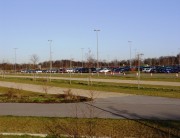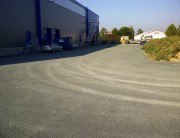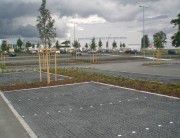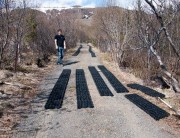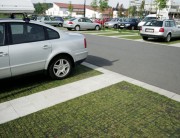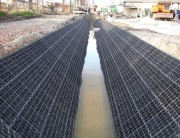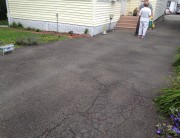Permeable Streets
(The New Age of Construction)
“The recollection of quality remains long after price is forgotten”
—Shoe Manufacturer E.C. Simmons [22 June 1922]
“The bitterness of poor quality remains long after the sweetness of low price is forgotten.”
—anonymous.
Do these quotes have an effect on you? Don’t they ring a bell inside saying: “Been there; done that.” Generally, you pay for what you get. Construction job sites throughout America are basically awarded on the lowest bidder. Though the intent of “Lowest Bidder” appears wise on the surface, it also sets up the opportunity for inferior quality, corruption and eventual cost burdening repairs. Enough!
Since the introduction of “Going Green Infrastructure” and “Sustainability” has been advocated by the Environmental Protection Agency (EPA), massive migration towards better quality and product efficiency has reappeared. Municipalities, public and private sector construction has shifted their design criteria to reflect the new growing trend within the building and landscaping industries. Towards the top of the list of wrong-doing or negative windfalls, are our roads. From super highways to small driveways, the wrath of poor construction and corrupt contractors flourish. Enough!
Roads in Europe generally last twice as long as American roads. That’s based primarily on design and maintenance models used by Europeans. Whereas, in America, more effort is placed on lowest-cost contracts and quick-fix repair mentality. Between 2008 and 2011, US States collectively spent $20.4 billion annually to build new roads and over $16.5 billion annually repairing and preserving the other 99 percent of roadways. According, State DOTs need to spend $43 billion dollars every year for 20 years to bring roads in poor condition into a good standard*. Enough!
Having a good road infrastructure with low maintenance is mandatory. Unfortunately, having the good-ol-boy network and distain for change, inhibits many construction contractors. We often hear: “Why change; it worked before.” This is common among local municipalities and town government levels. “Hey, I don’t need to risk my job on something new,” has been repeated to me often by engineers and designers. This is especially the case when decisions need to take place between asphalt and permeable pavements.
In recent years, pavement permeability has been introduced because of storm water and erosion control problems. Permeable asphalt, permeable concrete, a variety of concrete pavers, and the introduction of plastic permeable pavers have hit the design tables throughout the country. But the expense, quality and durability vary greatly among the products.
With this in mind, lets peek into how they differ. At approximately $7+ per square foot, concrete is great, expensive and last well over 20 years. Asphalt, on the other hand, can be less costly, has limited endurance and high maintenance cost. Priced starting at $3.50 per square foot, but high repair cost easily surpasses the cost of concrete. Concrete pavers are aesthetic and beautiful and come with a very high cost, but not practical on public roads. Then we have various permeable plastic grid-pavers that cost installed around $4.50 per square foot. Depending on quality, these could last much longer that asphalt with low maintenance and offers permeability. Note also, that permeability reduces the need for high cost drainage construction as the water flows into the ground and not surging into our over burdened sewer systems and contributing to floods.
Currently, many streets have deteriorated, especially in the northern States because of pavement expansion and contraction due to freezing winter temperatures. Salt is another road killer and car fenders tell that story well. Some streets have creators with teeth, ruts and waves, and water seepage. Worse yet, asphalt pothole patch-up jobs by maintenance crews truly insult the taxpayer with obvious short-term resolutions.
Needless to say, we are conditioned to accept the “Old way thinking” and tolerate the quick-fix asphalt resurfacing. Millions of dollars are spent over and over, year after year, because change is too risky. Enough!
Introducing the concept of PERMEABLE STREETS. Ideally, we desire the construction of our city streets to be safe, enduring, permeable and with very low maintenance. With permeable streets, using recycled LDPE plastic grids, which are filled with small pebble-like stones, we can achieve (1) a solid pavement, (2) permeability, (3) safety, (4) low maintenance, and (5) substantial long-term cost savings.
Play with the numbers yourself: on the average, asphalt weighs about 110 lbs/square yard for every inch of thickness in pavement. So a 100 sqyd area (30’ x 30’) at 4 inches deep equals 110 x 100 x 4 = 44,000 lbs, or 22 tons. Placed asphalt can range $80-100/ton. Sub-base is usually 30-40 cubic yards (usually 6-12 inches deep. Fabric is about $3/sqyd. Excavation and disposal runs about $20/sqyd. All this equates to $5.74 per square foot, installed on a basic flat site.
All this sounds initially good, but we need to consider adding for drains and culverts. This could cost hundreds per linear feet. In addition to that, we have periodical maintenance, including a top layer of asphalt and annual seal coating. Over an 18-year period, the cost of asphalt could easily mount to over $20 per square foot price tag. Incidentally, the installation process is intrusive to the environment, and since asphalt is a liquid, it is also a pollutant.
The good news is that LDPE Plastic Grid-Pavers cost virtually the same to install; they usually does not need drainage, offer minimal maintenance, if any, are environmentally friendly, offer non-intrusive installation, and are not a pollutant—they’re recycled products. So after an 18-year period, no additional cost is incurred.
Here’s my take on Permeable Streets:
- No more potholes
- It’s permeable and helps prevent storm water and erosion problems
- It’s a solid pavement structure that will last for many years
- It’s safe, and will actually deter speeding whereby reduces accidents
- It brings attention back into the environment.
- If can be easily replaced if damaged or subject to a utility repairs
- It offers good traction and prevents “black-ice” buildup
- It can be snow plowed
- It helps mitigate heat island build-up in urban areas
- It adds to the aesthetic value of the community
Lowering taxpayer obligations and redefining the infrastructure by permitting sustainability are two key factors that will eventually make Permeable Streets a reality. As we become less dependent on oil-based material and use recyclables in construction, we also become more aware of the need to respect and conserve our natural resources.
Using asphalt and concrete for major thoroughfares and super highways is well understood and practical. The concept of utilizing Permeable Streets for slow and low traffic applications in residential streets and commercial access roadways is common sense and when properly designed, beneficial and economical. Test drive a Permeable Street today!
Robert V Gerard
Partner, Green Way Pavements®
Copyright©2015 Robert V Gerard
www.GreenWayPavements.com
* Source: Smart Growth America/Taxpayers for Common Sense/March 2014





